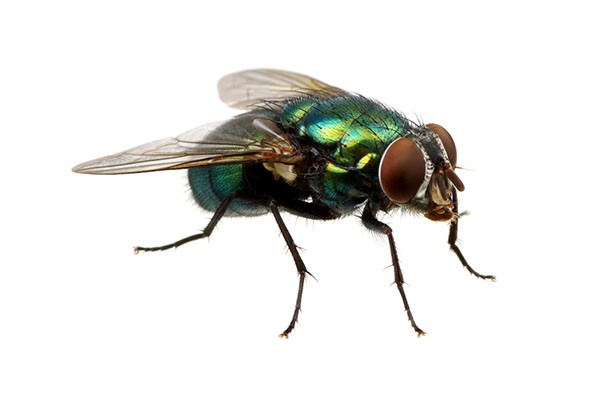House, blow, and flesh flies (oh my!) – how to combat filth flies
Several of our technicians have noticed filth fly problems recently, suggesting that they are already gearing up for summer. As is the case with fruit flies, understanding the pest can be essential to finding and eliminating its source.
Of the three most common filth flies, house flies are the smallest at a dainty 6-7 mm long. These dark gray flies have four dark lengthwise stripes on the thorax and yellowish, translucent-looking blotches on the sides of the abdomen. They feed on a range of decomposing organic matter, with a particularly strong attraction to poop. Blow flies tend to be a little larger than house flies and most have metallic coloring in hues of black, dark blue, or bright iridescent green, and are particularly fond of carrion (dead meat). Flesh flies are similar to houseflies in color, but are larger, more bristly, lack the yellowish blotches, often have a red butt, and have conspicuously large pads at the tips of their feet. Like blow flies, they are not picky eaters, but have a particular preference for carrion.
In addition to buzzing annoyingly in your home or workplace, these flies pose a health risk as they can transmit diseases. They vomit digestive fluids to liquefy solid foods, so whenever they land on your food, they are likely to vomit up residues from whatever carrion, feces, or other sludge they were recently feeding on. This vomit, as well as their poop, can easily transfer pathogens and parasites from their filth-based diet to your food. Furthermore, flesh flies deposit larvae rather than eggs, and eating meat contaminated with flesh fly larvae may, in rare situations, lead to a maggot infestation in the intestines.
Now that we know what pests we’re dealing with and why they are a serious issue, how do we get them under control? Sanitation is key – find and eliminate the decomposing filth in which they breed, and the infestation will subside over a few weeks. Think creatively about where their filth sources might be. A mouse or chipmunk carcass in a wall void, a cat litter box in need of cleaning, or meat packaging material in a trash can that is not emptied often enough are all reasonable places where flies can breed. Use the fly species as a very rough guide – houseflies may indicate poop, decomposing plant matter, or other relatively low-protein sludge, whereas blow flies or flesh flies are more indicative of high-protein materials such as meat, blood, dairy products, etc. Outdoors, other species can help with sanitation; carrion beetles and dung beetles both eat the same filth as flies, but each spends most of its time buried harmlessly out of sight rather than buzzing around people.
Pest management professionals can help you to pinpoint likely breeding sources for pest filth flies to focus sanitation efforts, as well as monitoring so that infestations can be detected and dealt with early. We can also use insecticides to quickly knock-down adults, which can help to quickly alleviate fly problems and more quickly identify whether sanitation efforts are successful.






